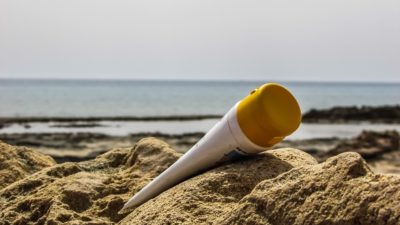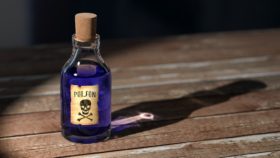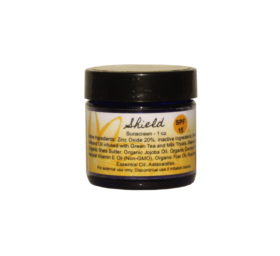
If you look at any commercial sunscreens you will see a lot of disclaimers, including that sunscreen does not prevent cancer, and the best approach to protect skin is to avoid the sun by wearing appropriate clothing. That may all be true, but that is not always practical, and that is not the whole story. Here is the rest of the story.
So, do you really need a sunscreen? The answer is:
Yes, you probably do need a sunscreen, but only if it has the correct beneficial ingredients, and none of the harmful ones. And how do you know if your sunscreen has beneficial ingredients instead of harmful ones? Read on to find out…
While it is true that some sunlight exposure is necessary for a person’s skin to produce adequate Vitamin D, excessive UV light exposure certainly contributes to skin damage, skin aging, and skin pathologies. As with most things, moderation is key, and getting either too little or too much sun is not advisable. Therefore taking appropriate protective measures, such as wearing sunscreen, to limit excess exposure makes sense. Here is a review on the “Role of UV light in photodamage, skin aging, and skin cancer: importance of photoprotection.“
There are also other considerations regarding whether or not you should add a sunscreen to your routine. One of those considerations is if you are on medications. This skin cancer informational site offers a list of medications that result in phototoxicity or photoallergy or both.
However, as of the date of this article, we don’t agree with the FDA regarding their current list of approved active sunscreen ingredients. The FDA’s current list of approved active ingredients can be found here: Sec. 352.10. Some of these I discuss in greater detail below (please note that many chemicals have more than one name).
Often, synthetic chemical active ingredients are used in sunscreens to make them more effective. These chemical ingredients can have a worse affect on your skin and overall health then the sun itself. Some examples of unsafe sunscreen active ingredients include: avobenzone, oxybenzone, octinoxate, octisalate, homosalate, octocrylene, and titanium dioxide. There is scientific research that shows that all of these active ingredients have safety concerns, ranging from causing cancer itself to endocrine and reproductive toxicity.

For example, avobenzone is an endocrine (hormone) disruptor via multiple mechanisms as noted in this study: “Endocrine Activity of AVB, 2MR, BHA, and Their Mixtures.“
And if you look at the wikipedia article for avobenzone, it clearly states that mixed with “chlorinated water and ultraviolet light can cause avobenzone to disintegrate into various other organic compounds, including aromatic acids, aldehydes, phenols, and acetyl benzynes. Some of these compounds are known to be cancer causing.”
Octocrylene is also an endocrine disruptor via several mechanisms as noted in the following study “Assessment of multiple hormone activities of a UV-filter (octocrylene) in zebrafish (Danio rerio.)“
Octocrylene, oxybenzone, and octinoxate are also a photosensitizers as noted in this study, (which seems completely contradictory to use as sunscreen ingredients). They are also pro-oxidants which can increase free radical damage to skin cells after 60 minutes of sun exposure. In other words, these ingredients are only effective for the first hour of exposure, but after an hour, they cause more skin damage than if you were to not use anything at all. Thus it makes no sense to use these as sunscreen ingredients.
Homosolate is an estrogenic endocrine disruptor as noted in the following study: “Interaction of polycyclic musks and UV filters with the estrogen receptor (ER), androgen receptor (AR), and progesterone receptor (PR) in reporter gene bioassays.“
Oxybenzone (also known as benzophenone-3) is an estrogenic endocrine disruptor as evidenced by the following studies:
“Endocrine-disrupting effect of the ultraviolet filter benzophenone-3 in zebrafish, Danio rerio.“
Octinoxate (also known as methoxycinnamate) may cause DNA damage as demonstrated in this study: “Different DNA damage response of cis and trans isomers of commonly used UV filter after the exposure on adult human liver stem cells and human lymphoblastoid cells.“

Some manufacturers may argue that titanium dioxide is safe. But a deeper review of the scientific literature shows that not only does titanium dioxide penetrate the skin (particularly nano size particles) and enter the bloodstream, but that it can also cause DNA damage and endocrine and (especially male) reproductive harm. So no, titanium dioxide is not truly safe.
For example, see the studies below.
“Exposure to TiO2 Nanoparticles Induces Immunological Dysfunction in Mouse Testitis.“
“High sensitivity of testicular function to titanium nanoparticles.“
Another argument we hear is that these chemical “UV filter” active ingredients do not penetrate the skin, but the research in this area is contradictory and therefore controversial. The results depend greatly on the testing methodology, and some testing methods show that there is definitely deeper penetration of these chemicals. This study found that 1%-2% of oxybenzone is systemically absorbed through human skin. This may not seem like a lot, but only small amounts of these chemicals are required to show harm, and additionally these chemicals tend to bioaccumulate over time. For example, The Centers for Disease Control and Prevention (CDC) has detected oxybenzone in more than 96 percent of the American population, based on a representative sampling of children and adults. That study can be found here: “Concentrations of the sunscreen agent benzophenone-3 in residents of the United States: National Health and Nutrition Examination Survey 2003–2004.” Furthermore, participants who reported using sunscreen have higher oxybenzone exposures, according to this study. Finally, this study found that not only is oxybenzone absorbed through the skin in significant amounts, but that it can take many days for all of it to be eliminated from the body through excretion. So clearly these chemicals ARE, without question, getting into people, one way or another. The latter studies support that they are getting into people via skin exposure. You can see some of the additional related studies we found below:
“Commonly used UV filter toxicity on biological functions: review of last decade studies.”

You can also read Environmental Working Group (EWG)’s article on “The Trouble With Ingredients in Sunscreens“, including a handy chart on some of the approved ingredients and their known effects. While we do not agree with all of the EWG’s assessments, they are far better researched than what the FDA has provided.
This article from 2015 describes the current state of sunscreen active ingredients, and that the reason the FDA has not approved additional (chemical) active ingredients is because they are not convinced the new proposed ingredients are safe. The FDA has since provided new guidelines for what they require for approval of new sunscreen active ingredients. The combination of these events leads us to believe that the FDA is not likely to approve any new active ingredients any time soon.
And of course, these are just the approved FDA sun-blocking ingredients. This list doesn’t include the added stabilizers and fungicides often added to many personal care products including sunscreen. You can read more about common ingredients and why they are unhealthy in part I here and part II here.
With that said, we used to never wear sunscreen. We simply decided that the risks of most sunscreens outweighed the benefits, and it was easy to avoid the sun. We would just wear long sleeves or hats, stay indoors, and overall protect ourselves from UV radiation. No sunscreen needed.
That was until I got a job that required me to be out in the sun for long periods of time. No matter what I tried, avoiding the sun was not an option. A person can only wear a long sleeved shirt in 100 degree weather for so long, and hats and sunglasses only do so much to protect ones face, neck and ears from the sun. After coming home burnt to a crisp on a regular basis, Tober finally insisted that we do what we do in all other such situations: we would formulate and create our own sunscreen.

We spent a couple months researching ingredients that had scientific research or testing behind them. We tried several formulations, and eventually we narrowed it down to one, which was the Shield Sun Care we offered for a short while. That was until some of the research on one of the major ingredients came back redacted, and the SPF testing done at an independent lab came back lower than the data implied it should.
So we pulled the Sun Care off the shelf, and started over. Here at Nature’s Complement, customer safety and satisfaction supersede everything else, including months worth of research that had to be thrown out in the garbage.
We were not discouraged however, as our Shield Sun Care did offer sun-blocking properties, and I used it an entire hot sunny summer with good results. But we decided to improve it, we dove further into the research, and came up with a new, much better formulation. The new formula includes the following ingredients that have research to support that they either block UV light or that they otherwise help to protect against UV-induced skin damage and skin cancer.

Zinc oxide (standard particle size, not the nano size particles) – The primary sun-blocking agent is zinc oxide. This is an FDA approved active ingredient and provides broad protection from UVA and UVB with negligible toxicity. You can see a couple of our favored studies below:
“Risk assessment of zinc oxide, a cosmetic ingredient used as a UV filter of sunscreens.“
Zinc oxide is currently the only FDA approved active sunscreen ingredient that the science demonstrates is both effective and truly safe.
We want to point out that we only use standard particle size zinc oxide in our sunscreen and we do NOT use nano size particles as many manufacturers have started to do. The reason for this is simple: nanoparticles more easily penetrate the skin, enter circulation, and there are numerous studies showing that metallic nanoparticles (including zinc oxide) have significant toxicology concerns. Below are just a few of the many studies we found on toxicity of nanoparticles. Therefore we will never use nano anything in our products.
“Size dependent toxicity of zinc oxide nano-particles in soil nematode Caenorhabditis elegans.“
“Size-dependent effect of zinc oxide on toxicity and inflammatory potential of human monocytes.“
“Cardiotoxicity of nano-particles.“

Milk thistle – Normally a noxious weed, but alas, everything has its benefits. One of the mechanisms by which UV light damages cells is by causing DNA damage. If this type of DNA damage can be prevented, it not only reduces the risk of skin cancer, but it also reduces the amount of skin photoaging that occurs due to UV exposure. Fortunately, milk thistle contains natural compounds know as silymarin and silibinin which have been shown to protect skin cells (keratinocytes) from UV-induced DNA damage. Basically, exactly what we would want. You can read up on some of these studies below:
In addition, silymarin has been shown to inhibit growth of melanoma (skin cancer) as recognized in this study: “Silymarin inhibits melanoma cell growth both in vitro and in vivo by targeting cell cycle regulators, angiogenic biomarkers and induction of apoptosis.”

Green tea (camellia sinensis) – Green tea has long been known as having anti-cancer properties, and this is also true related to skin cells and skin cancer. Similarly to milk thistle, green tea has been found to help promote the repair of UV-induced DNA damage. Again, studies noted below:
A compound in green tea known as epigallocatechin-3-gallate (EGCG) also protects against photocarcinogenesis (UV-induced cancer) via several pathways, including inhibiting cancer cells ability to form new blood vessels, and upregulation of tumor suppressor genes. You can read some of these studies below:
In addition, we found studies that show that compounds in green tea function as protective antioxidants, and prevent increases in matrix metalloproteinases (MMPs) which are involved in the breakdown of skin and connective tissue:
“Skin photoprotection by green tea: antioxidant and immunomodulatory effects.“
For background, MMPs normally function continuously but at a low level of activity, as part of normal tissue breakdown and repair (remodeling). When many types of tissue damage occur, including that caused by UV exposure, the activity of MMPs increases significantly. This can cause accelerated breakdown of collagen and elastin, two proteins essential to maintaining skin integrity, fullness, and elasticity.

Astaxanthin sourced from Haematococcus pluvialis – Astaxanthin is a naturally occurring antioxidant compound in the carotenoid family, which various organisms use as an innate mechanism to protect themselves from UV-caused damage. This is not directly a sun-blocking compound, but what it does do is protect from several of the changes in skin that UV light can cause. For example, similarly to green tea and rosemary (discussed below), it prevents increases in matrix metalloproteinases (MMPs) that are involved in the breakdown of skin tissue: “Astaxanthin attenuates the UVA-induced up-regulation of matrix-metalloproteinase-1 and skin fibroblast elastase in human dermal fibroblasts“
This next study shows that astaxanthin prevented UV-induced skin damage: “Protective effects of topical application of a poorly soluble antioxidant astaxanthin liposomal formulation on ultraviolet-induced skin damage“
In addition, the next study shows that astaxanthin is also effective at protecting against UVB-induced skin damage: “A Combination of Soybean and Haematococcus Extract Alleviates Ultraviolet B-Induced Photoaging.“
Here is a study showing that astaxanthin inhibited secretion of pro-inflammatory cytokines (immune signaling molecules) by skin cells. This type of inflammatory reaction is common when skin is exposed to excessive UV light. The inflammation that such cytokines produce usually contribute to skin aging and wrinkling: “The Inhibitory Effects of Anti-Oxidants on Ultraviolet-Induced Up-Regulation of the Wrinkling-Inducing Enzyme Neutral Endopeptidase in Human Fibroblasts.“
The following study, while not being specifically related to UV or sun protection, showed that topical application of astaxanthin improved skin texture and reduced fine lines such as “crows feet”: “Cosmetic benefits of astaxanthin on humans subjects*“
Similarly, astaxanthin has been shown to increase collagen production in human dermal fibroblasts (skin cells): “Enriched Astaxanthin Extract from Haematococcus pluvialis Augments Growth Factor Secretions to Increase Cell Proliferation and Induces MMP1 Degradation to Enhance Collagen Production in Human Dermal Fibroblasts.“

Rosemary essential oil – Like some of the other ingredients mentioned, Rosemary does not provide direct UV blocking activity, but helps to ameliorate UV-induced damage to skin cells. Rosemary functions as an anti-oxidant and has been shown to protect DNA from UV damage: “Protective effects of citrus and rosemary extracts on UV-induced damage in skin cell model and human volunteers.“
And like both green tea and astaxanthin, rosemary prevents increases in matrix metalloproteinases (MMPs) that are involved in the breakdown of skin tissue: “Carnosic acid, a phenolic diterpene from rosemary, prevents UV-induced expression of matrix metalloproteinases in human skin fibroblasts and keratinocytes.“
In addition, rosemary has been shown to inhibit growth of melanoma (skin cancer) cells: “Rosmarinus officinalis extract inhibits human melanoma cell growth.“
Finally, rosemary contains the compound camphor which has been shown to reduce UV-induced wrinkle formation by increasing the amount of collagen that skin cells (dermal fibroblasts) produce: “Camphor Induces Proliferative and Anti-senescence Activities in Human Primary Dermal Fibroblasts and Inhibits UV-Induced Wrinkle Formation in Mouse Skin.“ The above is just a sampling of the research studies we found while reformulating our sunscreen.
The above is just a sampling of the research studies we found while reformulating our sunscreen.
Additional ingredients of our new sunscreen include: sweet almond oil, beeswax, organic shea butter, organic jojoba oil, organic coconut oil, natural vitamin E oil (non-GMO), and organic flax oil.
So as you can see, our new formulation provides many skin protecting ingredients, some of which also have other skin health benefits. We basically created a formula that includes all of the most effective and safest ingredients. We think this is an outstanding product, and we also think it is one of the safest sunscreens on the market. As always, we do not use any questionable ingredients.
This new sunscreen formulation has completed SPF testing, and has FDA approval for a SPF 15 rating.
For more information on SPF rating and what it really means, see our article “SPF: What Does It Mean, And Why You Should Care.“
For Health,
Rob
Nature's Complement is a participant in the Amazon Services LLC Associates Program, an affiliate advertising program. If you purchase products on Amazon through any of our affiliate links, we get a small percentage of the transaction, at no extra cost to you. We spend a lot of time writing the articles on this site, and all this information is provided free of charge. When you use our affiliate links, you support the writing you enjoy without necessarily buying our products. (However we would appreciate if you would do that too!) Thank you for helping to support our work, however you choose to do so.
These statements have not been evaluated by the Food and Drug Administration. This information and/or products are not intended to diagnose, treat, cure or prevent any disease.




[…] protection. Watch out for them on labels, as they will be specifically mentioned. I have written an entire separate article on the safety of sunscreens, so with this section I will try to provide a brief […]